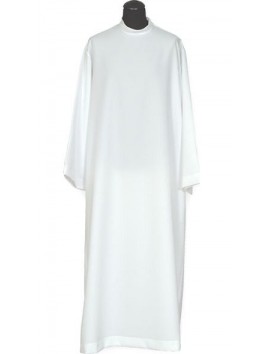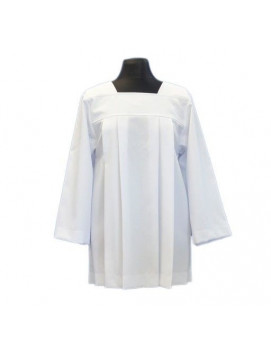No products
Altar server surplice
An altar server surplice is a liturgical vestment worn by altar servers during Mass in the Catholic Church. It is a white, lightweight, and loose-fitting garment that is worn over the server's clothing and reaches down to the knees. Altar server surplices are typically made of cotton, viscose, polyester, or lace. The surplice is a symbol of purity and is worn to signify the server's role in assisting the priest during the Mass. Altar server surplices are available in various sizes and styles, including pleated and square neck designs
An altar server surplice is a liturgical vestment worn by altar servers during Mass in the Catholic Church. It is a white, lightweight, and loose-fitting garment that is worn over the server's clothing and reaches down to the knees. Altar server surplices are typically made of cotton, viscose, polyester, or lace. The surplice is a symbol of purity and is worn to signify the server's role in assisting the priest during the Mass. Altar server surplices are available in various sizes and styles, including pleated and square neck designs
The Altar Server Surplice: A Symbol of Service and Purity
The altar server surplice is a garment steeped in tradition, symbolizing the dedication and purity of those who assist in the sacred liturgy. Let's delve into the significance of this vestment and its role in the church.What is an Altar Server Surplice?
An altar server surplice is a white, tunic-like garment worn over a cassock during liturgical services. It reaches to the waist or ankles and features wide sleeves, often adorned with lace or embroidered borders. The surplice represents the white garment received at Baptism and is a miniature version of the alb, a symbol of purity.The Role of the Surplice in Liturgy
The surplice is not just a piece of clothing; it's a symbol of the server's role as a servant of God. It's worn by clergy, lectors, acolytes, and altar servers, who stand in for instituted acolytes during liturgical services. The surplice is a visual distinction from the priest and signifies the server's commitment to serving God.Quality and Craftsmanship
High-quality materials and craftsmanship are essential for surplices, as they must endure regular use and maintain a dignified appearance. They are made from durable fabrics like poly-cotton blends and are designed for a comfortable fit and ease of movement.Versatility and Functionality
Surplices are versatile and suitable for various occasions, from religious processions to weddings. They come in different sizes for children and adults and can be customized to meet specific needs.The Evolution of the Surplice
The surplice has evolved over time, originally reaching nearly to the ground and later shortening to knee-length or shorter. Variations include sleeveless surplices and those with slit arms, catering to different roles like organists.The Surplice in Different Traditions
In the Anglican tradition, the surplice is known as a cotta when it's a cut-off version of the alb. The surplice is part of the choir dress for clergy but is not typically worn by prelates who wear the rochet instead.The Surplice and Gender Inclusivity
The surplice has been a topic of debate regarding gender inclusivity. Some parishes have returned to using cassocks and surplices for altar servers, while others prefer albs, especially for female servers. This has led to discussions about the appropriateness of attire for female altar servers.FAQs About the Altar Server Surplice
Why do altar servers wear a surplice?Altar servers wear a surplice to distinguish themselves from the clergy and to symbolize their role as servants of God, reflecting their dedication and the purity of their service.
Yes, girls can wear a surplice. While there has been some controversy, many dioceses have policies that allow both male and female altar servers to wear surplices.
Yes, the surplice is traditionally worn over a cassock and never alone. It is not gathered by a belt or cincture.
The surplice is a shorter, often more decorated version of the alb, which is a long white garment symbolizing the baptismal robe. The surplice is a miniature alb, reflecting the same symbolism of purity.











